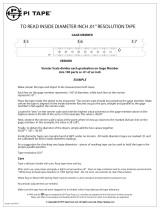
3
LabVIEW National Instruments LabVIEW™ software is a graphical
programming language sold by National Instruments. It is used with SensorDAQ
and can be used with a number of other Vernier interfaces. See
www.vernier.com/labview for more information.
NOTE: Vernier products are designed for educational use. Our products are not
designed nor recommended for any industrial, medical, or commercial process such
as life support, patient diagnosis, control of a manufacturing process, or industrial
testing of any kind.
How the Dual-Range Force Sensor Works
The Dual-Range Force Sensor uses strain gage technology to measure force, based
on the bending of a beam. Strain gages attached to both sides of the beam change
resistance as the beam bends. The strain gages are used in a bridge circuit such that a
small change in resistance will result in a change in voltage. This voltage change is
proportional to the change in force. A switch allows you to select either of two
ranges: 10 N or 50 N.
This sensor is equipped with circuitry that supports auto-ID. When used with
LabQuest 2, LabQuest, LabQuest Mini, LabPro, Go! Link, SensorDAQ, TI-Nspire
Lab Cradle, EasyLink, or CBL 2, the data-collection software identifies the sensor
and uses pre-defined parameters to configure an experiment appropriate to the
recognized sensor.
The Two Switch Settings–Resolution and Range
As with any instrument, there is a trade-off between accuracy and the range of forces
that can be measured. In general, you should use the 10 N range if you can. If the
forces exceed ten newtons, you need to use the 50 N range. In normal use, the
resolution with the two different switch settings will be
10 N 0.01N Stored Calibration slope: –4.9 N/V
intercept: 12.25 N
50 N 0.05 N Stored Calibration slope: –24.5 N/V
intercept: 61.25 N
Optional Calibration Procedure
You should not have to perform a new calibration when using the Dual-Range Force
Sensor in the classroom. We set the sensor to match our stored calibration before
shipping. You can simply use the appropriate calibration file that is stored in your
data-collection program from Vernier. In many cases, you can load an experiment
file that is designed for use with the Dual-Range Force Sensor and you are ready to
collect data.
The sensor is sensitive enough to measure the weight of the sensor hook. To
minimize this effect, simply place the sensor in the orientation in which it will be
used (horizontal or vertical) and choose zero in the software. This will define the
current situation as 0 N of force.
If you want to improve the calibration, it is easy to recalibrate. Follow the same
procedure used in calibrating most Vernier sensors–a two point calibration. One of
4
the points is usually with no force applied. Select the calibration option in the
program you are using and remove all force from the sensor. Enter 0 as the first
known force. Now apply a known force to the senor. The easiest way to do this is to
hang a labeled mass from the hook on the end of the sensor. Enter the weight of the
mass (Note: 1 kg applies a force of 9.8 newtons). For calibration using the 10 N
range, we recommend using 300 g of mass (2.94 N) for the second calibration point.
For calibration using the 50 N range, we recommend using a 1 kg mass (9.8 N) for
this second calibration point. Be careful not to exceed the selected range setting
during calibration. If you plan to use the Dual-Range Force Sensor in a different
orientation (horizontal vs. vertical) than calibrated, zero the Force Sensor to account
for this. This additional step makes the sensor read exactly zero when no force is
applied.
Mounting on a Ring Stand
The Dual-Range Force Sensor is designed to be mounted on a ring stand in several
different ways. Use a 13 mm rod extended through the hole in the Dual-Range Force
Sensor. Tighten the thumb screw.
Mounting on a Dynamics Cart
The Dual-Range Force Sensor was designed for easy mounting on a Vernier or
PASCO dynamics cart.
Vernier Dynamics Cart
First mount the post to the cart and tighten. Then mount the Dual-Range Force
Sensor to the post using the thumb screw.
Mounted for vertical
data collection
Mounted for horizontal
data collection






